|
BAYAMO
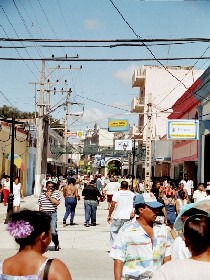 Bayamo is the capital of the province of Granma. In the last days of the XIX century, it had the historical privilege of becoming the capital of the Republic in Arms and in its historical centre one can see the birth house of the Cuban patriot and Father of the Homeland, Carlos Manuel de Céspedes, as well as the Anthem Plaza (Plaza del Himno) and the Cathedral, all places very much related to its history.
It was the second villa founded by Diego Velásquez in 1513, and today is a National Monument. It is mainly characterised by the impressive contrast between the mountains and the flatland, and is located in the southwest portion of the extreme eastern point of the island. Historically, its inhabitants have never given up their taste for riding in horse-drawn carriages, a custom that dates back to the colonial period. This tradition has inspired poets and musical composers.
Bayamo is the capital of the province of Granma. In the last days of the XIX century, it had the historical privilege of becoming the capital of the Republic in Arms and in its historical centre one can see the birth house of the Cuban patriot and Father of the Homeland, Carlos Manuel de Céspedes, as well as the Anthem Plaza (Plaza del Himno) and the Cathedral, all places very much related to its history.
It was the second villa founded by Diego Velásquez in 1513, and today is a National Monument. It is mainly characterised by the impressive contrast between the mountains and the flatland, and is located in the southwest portion of the extreme eastern point of the island. Historically, its inhabitants have never given up their taste for riding in horse-drawn carriages, a custom that dates back to the colonial period. This tradition has inspired poets and musical composers.
For more information:
www.cuba-bayamo.com
,
www.cuba-granma.com
|
|
|
CASTLE OF SAN PEDRO DE LA ROCA
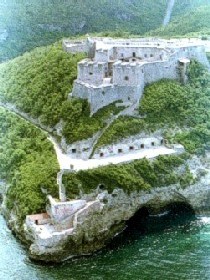 The castle, also known as the Morro Castle, was constructed between 1638 and 1643 by military engineer Juan Bautista Antonelli. The fort houses the museum of piracy and is a national monument.
The castle was declared World Heritage by Mr. Bernd von Droste, director of the World Heritage Center. “This is a remarkable example of Hispanic-American military architecture” said Von Droste in the proclamation ceremony. The Castle of San Pedro de la Roca has many historical, artistic, and architectonic values. This city is a must for the tourists.
The castle, also known as the Morro Castle, was constructed between 1638 and 1643 by military engineer Juan Bautista Antonelli. The fort houses the museum of piracy and is a national monument.
The castle was declared World Heritage by Mr. Bernd von Droste, director of the World Heritage Center. “This is a remarkable example of Hispanic-American military architecture” said Von Droste in the proclamation ceremony. The Castle of San Pedro de la Roca has many historical, artistic, and architectonic values. This city is a must for the tourists.
For more information:
www.cuba-santiagodecuba.com
|
|
|
La Demajagua
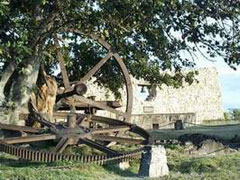 It is a place of true patriotic value to the Cubans, due to the fact that the father of the Homeland (Padre de la Patria), Carlos Manuel de Céspedes, announced the start of the first war of independence against Spanish colonialism on October 10th of 1868. Céspedes, a man of progressive ideas and a fervent promoter of independence, had decided to establish himself there two years before buying the place from his brother Francisco Javier.
Today it is known as the National Museum Park of La Demajagua (Museo Parque Nacional La Demajagua) and it was declared a National Monument on June 6th of 1978. It originally was a small sugar mill located in the municipality of Manzanillo, in the present day province of Granma. The exact date of its founding is not known, but it already existed by that name in the year of 1840.
It is a place of true patriotic value to the Cubans, due to the fact that the father of the Homeland (Padre de la Patria), Carlos Manuel de Céspedes, announced the start of the first war of independence against Spanish colonialism on October 10th of 1868. Céspedes, a man of progressive ideas and a fervent promoter of independence, had decided to establish himself there two years before buying the place from his brother Francisco Javier.
Today it is known as the National Museum Park of La Demajagua (Museo Parque Nacional La Demajagua) and it was declared a National Monument on June 6th of 1978. It originally was a small sugar mill located in the municipality of Manzanillo, in the present day province of Granma. The exact date of its founding is not known, but it already existed by that name in the year of 1840.
For more information:
www.cuba-history.com
,
www.cuba-granma.com
|
|
|
LA GRAN PIEDRA (THE GREAT STONE)
This peculiar monolith has an extension of 8,295.33 acres and it is located in the Sierra Maestra National Park 18.64 mi from Santiago de Cuba. The rock is 738.19 ft above sea level; specialists estimate it weighs 70, 000 tons. The stone 167.32 ft long, 98.43 ft wide, and 85.30 ft high was included in the Guinnes Records Book.
Temperature drops of 4.00 degrees Celsius and a dense fog has been reported here due to its microclimate.
The vegetation consists mainly of ferns and orchids. The Cartacuba and the Tocororo are common birds in the region.
During the Cuban cycling tour the cyclists find this mountain stage as the most challenging.
For more information:
www.cuba-santiagodecuba.com
|
|
|
MANZANILLO
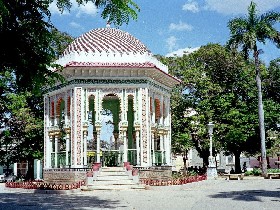 This beautiful coastal city features an intensely blue sea, is second in importance in the province, but also its main port. Here, there are many historical sites, such as “La Demajagua” sugar mill, which used to be the property of Carlos Manuel de Céspedes, who freed his slaves in 1868 and invited them to fight for Cuba’s independence.
Also worth visiting is the Cuban Nationality House (Casa de la Nacionalidad Cubana), founded on October 20th of 1991. The city, home to the Guacanayabo, invites dancing to the rhythm of the eastern organ, one of the most ancient musical traditions of the place.
Among the varied attractions are the keys of Guacanayabo, a part of the well-known southern terraces of the insular platform, where the beach of Punta del Inglés is located, in the most southern area of Cuba.
This beautiful coastal city features an intensely blue sea, is second in importance in the province, but also its main port. Here, there are many historical sites, such as “La Demajagua” sugar mill, which used to be the property of Carlos Manuel de Céspedes, who freed his slaves in 1868 and invited them to fight for Cuba’s independence.
Also worth visiting is the Cuban Nationality House (Casa de la Nacionalidad Cubana), founded on October 20th of 1991. The city, home to the Guacanayabo, invites dancing to the rhythm of the eastern organ, one of the most ancient musical traditions of the place.
Among the varied attractions are the keys of Guacanayabo, a part of the well-known southern terraces of the insular platform, where the beach of Punta del Inglés is located, in the most southern area of Cuba.
For more information:
www.cuba-granma.com
|
|
|
SANTA IFIGENIA CEMETERY
The cemetery was inaugurated on April 22nd 1868. it has an extension of 264,058.40 sq ft and it’s regarded as a museum.
Several illustrious Cubans are buried here: National Hero José Martí; Founding Father Carlos Manuel de Céspedes; Mariana Grajales, mother of the Maceo brothers; Frank País, murdered during the Batista dictatorship.
The cemetery is plethoric of funeral art samples in a magnificent state of preservation.
The city, a living piece of Cuban history, was declared as National Monument on October 10th, 1988.
For more information:
www.cuba-santiagodecuba.com
|
|
|
SANTIAGO DE CUBA
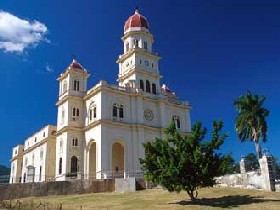 Santiago is the capital city of the province of the same name. Santiago de Cuba has a unique history, very distinctive people, and musical roots enriched by the mixture of races and cultures that make this city the most Caribbean city of Cuba.
The city is the only Cuban city to hold the title of “Hero City of the Republic of Cuba”.
The streets of city are full of historic events by its brave people from the first wars of independence in the 19th century to the attack on the Moncada Barracks in 1953.
Seventeen sites of the city are considered national monuments; this brave city has history everywhere.
The city was founded in 1515 marking the beginning of the Spanish colonialism in the Caribbean. The historical center stretches for 1.55 sq mi. The city sits on top of marine terraces and it’s sheltered by the Sierra Maestra mountain range. The historical center’s limits mark the extension the city had until late 19th century. It shows many elements of colonial and republican architecture.
The city’s superb natural resources favor the practice of ecotourism, especially trailing and adventure tourism; and it has an adequate infrastructure for congress tourism as well as nautical sports, cruises, and health tourism.
Santiago is the capital city of the province of the same name. Santiago de Cuba has a unique history, very distinctive people, and musical roots enriched by the mixture of races and cultures that make this city the most Caribbean city of Cuba.
The city is the only Cuban city to hold the title of “Hero City of the Republic of Cuba”.
The streets of city are full of historic events by its brave people from the first wars of independence in the 19th century to the attack on the Moncada Barracks in 1953.
Seventeen sites of the city are considered national monuments; this brave city has history everywhere.
The city was founded in 1515 marking the beginning of the Spanish colonialism in the Caribbean. The historical center stretches for 1.55 sq mi. The city sits on top of marine terraces and it’s sheltered by the Sierra Maestra mountain range. The historical center’s limits mark the extension the city had until late 19th century. It shows many elements of colonial and republican architecture.
The city’s superb natural resources favor the practice of ecotourism, especially trailing and adventure tourism; and it has an adequate infrastructure for congress tourism as well as nautical sports, cruises, and health tourism.
For more information:
www.cuba-santiagodecuba.com
|
|
|
SIERRA MAESTRA
 The Sierra is found to the south of the province of Granma and is the highest mountain chain in Cuban geography. The peak of the Turquino mountain (pico real del Turquino) is 1730 metres above sea level. The Sierra is the birthplace of the province’s most important rivers, among them El Cauto, the longest of the Cuban rivers, together with others such as Cautillo, Contramaestre, Bayamo, Guisa, Guamá, all forming part of the extensive Cauto basin.
In the southern area of the Sierra, are the deltas of Mota and Macío. The Delta of the Cauto River, a refuge for the flora and fauna that inhabits it, is some 70 kilometres from Bayamo. It was declared a Ramsar site, an environmental category for humidness of UNESCO. It covers some 61 700 hectares. Enormous extensions of mangrove swamps and swamp grasslands are characteristic of this area.
The Sierra is found to the south of the province of Granma and is the highest mountain chain in Cuban geography. The peak of the Turquino mountain (pico real del Turquino) is 1730 metres above sea level. The Sierra is the birthplace of the province’s most important rivers, among them El Cauto, the longest of the Cuban rivers, together with others such as Cautillo, Contramaestre, Bayamo, Guisa, Guamá, all forming part of the extensive Cauto basin.
In the southern area of the Sierra, are the deltas of Mota and Macío. The Delta of the Cauto River, a refuge for the flora and fauna that inhabits it, is some 70 kilometres from Bayamo. It was declared a Ramsar site, an environmental category for humidness of UNESCO. It covers some 61 700 hectares. Enormous extensions of mangrove swamps and swamp grasslands are characteristic of this area.
For more information:
www.cuba-granma.com
|
|
|
TURQUINO ROYAL PEAK (PICO REAL DEL TURQUINO)
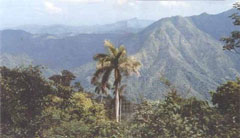 Declared a National Monument, its summit is 1 974 metres above sea level, a part of the mountain massif of the Sierra Maestra and it is the highest elevation in the country. This mountain scenario covers some 17 450 hectares in the provinces of Santiago de Cuba and Granma. Where many native species dwell among the rivers, forests, abundant flora and fauna.
The area was the main operations theatre of the struggle that Fidel Castro at the head of the Rebel Army (Ejército Rebelde) waged for over 25 months against the dictator Fulgencio Batista. On the summit, there is a bust of the National Cuban Hero José Martí and on the accompanying plaque, some words of the Teacher: Scarce as the mountains are, are the men who know how to gaze from them and feel within themselves their nation or humanity.
Declared a National Monument, its summit is 1 974 metres above sea level, a part of the mountain massif of the Sierra Maestra and it is the highest elevation in the country. This mountain scenario covers some 17 450 hectares in the provinces of Santiago de Cuba and Granma. Where many native species dwell among the rivers, forests, abundant flora and fauna.
The area was the main operations theatre of the struggle that Fidel Castro at the head of the Rebel Army (Ejército Rebelde) waged for over 25 months against the dictator Fulgencio Batista. On the summit, there is a bust of the National Cuban Hero José Martí and on the accompanying plaque, some words of the Teacher: Scarce as the mountains are, are the men who know how to gaze from them and feel within themselves their nation or humanity.
For more information:
www.cuba-history.com
,
www.cuba-granma.com
|
|
|
TWO RIVERS (DOS RÍOS)
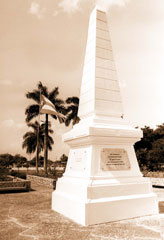 TWO RIVERS (DOS RÍOS)
TWO RIVERS (DOS RÍOS)
For more information:
www.cuba-heroes.com
,
www.cuba-history.com
,
www.cuba-josemarti.com
,
www.cuba-granma.com
|
|
 Bayamo is the capital of the province of Granma. In the last days of the XIX century, it had the historical privilege of becoming the capital of the Republic in Arms and in its historical centre one can see the birth house of the Cuban patriot and Father of the Homeland, Carlos Manuel de Céspedes, as well as the Anthem Plaza (Plaza del Himno) and the Cathedral, all places very much related to its history.
It was the second villa founded by Diego Velásquez in 1513, and today is a National Monument. It is mainly characterised by the impressive contrast between the mountains and the flatland, and is located in the southwest portion of the extreme eastern point of the island. Historically, its inhabitants have never given up their taste for riding in horse-drawn carriages, a custom that dates back to the colonial period. This tradition has inspired poets and musical composers.
Bayamo is the capital of the province of Granma. In the last days of the XIX century, it had the historical privilege of becoming the capital of the Republic in Arms and in its historical centre one can see the birth house of the Cuban patriot and Father of the Homeland, Carlos Manuel de Céspedes, as well as the Anthem Plaza (Plaza del Himno) and the Cathedral, all places very much related to its history.
It was the second villa founded by Diego Velásquez in 1513, and today is a National Monument. It is mainly characterised by the impressive contrast between the mountains and the flatland, and is located in the southwest portion of the extreme eastern point of the island. Historically, its inhabitants have never given up their taste for riding in horse-drawn carriages, a custom that dates back to the colonial period. This tradition has inspired poets and musical composers.
 The castle, also known as the Morro Castle, was constructed between 1638 and 1643 by military engineer Juan Bautista Antonelli. The fort houses the museum of piracy and is a national monument.
The castle was declared World Heritage by Mr. Bernd von Droste, director of the World Heritage Center. “This is a remarkable example of Hispanic-American military architecture” said Von Droste in the proclamation ceremony. The Castle of San Pedro de la Roca has many historical, artistic, and architectonic values. This city is a must for the tourists.
The castle, also known as the Morro Castle, was constructed between 1638 and 1643 by military engineer Juan Bautista Antonelli. The fort houses the museum of piracy and is a national monument.
The castle was declared World Heritage by Mr. Bernd von Droste, director of the World Heritage Center. “This is a remarkable example of Hispanic-American military architecture” said Von Droste in the proclamation ceremony. The Castle of San Pedro de la Roca has many historical, artistic, and architectonic values. This city is a must for the tourists.
 It is a place of true patriotic value to the Cubans, due to the fact that the father of the Homeland (Padre de la Patria), Carlos Manuel de Céspedes, announced the start of the first war of independence against Spanish colonialism on October 10th of 1868. Céspedes, a man of progressive ideas and a fervent promoter of independence, had decided to establish himself there two years before buying the place from his brother Francisco Javier.
Today it is known as the National Museum Park of La Demajagua (Museo Parque Nacional La Demajagua) and it was declared a National Monument on June 6th of 1978. It originally was a small sugar mill located in the municipality of Manzanillo, in the present day province of Granma. The exact date of its founding is not known, but it already existed by that name in the year of 1840.
It is a place of true patriotic value to the Cubans, due to the fact that the father of the Homeland (Padre de la Patria), Carlos Manuel de Céspedes, announced the start of the first war of independence against Spanish colonialism on October 10th of 1868. Céspedes, a man of progressive ideas and a fervent promoter of independence, had decided to establish himself there two years before buying the place from his brother Francisco Javier.
Today it is known as the National Museum Park of La Demajagua (Museo Parque Nacional La Demajagua) and it was declared a National Monument on June 6th of 1978. It originally was a small sugar mill located in the municipality of Manzanillo, in the present day province of Granma. The exact date of its founding is not known, but it already existed by that name in the year of 1840.
 This beautiful coastal city features an intensely blue sea, is second in importance in the province, but also its main port. Here, there are many historical sites, such as “La Demajagua” sugar mill, which used to be the property of Carlos Manuel de Céspedes, who freed his slaves in 1868 and invited them to fight for Cuba’s independence.
Also worth visiting is the Cuban Nationality House (Casa de la Nacionalidad Cubana), founded on October 20th of 1991. The city, home to the Guacanayabo, invites dancing to the rhythm of the eastern organ, one of the most ancient musical traditions of the place.
Among the varied attractions are the keys of Guacanayabo, a part of the well-known southern terraces of the insular platform, where the beach of Punta del Inglés is located, in the most southern area of Cuba.
This beautiful coastal city features an intensely blue sea, is second in importance in the province, but also its main port. Here, there are many historical sites, such as “La Demajagua” sugar mill, which used to be the property of Carlos Manuel de Céspedes, who freed his slaves in 1868 and invited them to fight for Cuba’s independence.
Also worth visiting is the Cuban Nationality House (Casa de la Nacionalidad Cubana), founded on October 20th of 1991. The city, home to the Guacanayabo, invites dancing to the rhythm of the eastern organ, one of the most ancient musical traditions of the place.
Among the varied attractions are the keys of Guacanayabo, a part of the well-known southern terraces of the insular platform, where the beach of Punta del Inglés is located, in the most southern area of Cuba.
 Santiago is the capital city of the province of the same name. Santiago de Cuba has a unique history, very distinctive people, and musical roots enriched by the mixture of races and cultures that make this city the most Caribbean city of Cuba.
The city is the only Cuban city to hold the title of “Hero City of the Republic of Cuba”.
The streets of city are full of historic events by its brave people from the first wars of independence in the 19th century to the attack on the Moncada Barracks in 1953.
Seventeen sites of the city are considered national monuments; this brave city has history everywhere.
The city was founded in 1515 marking the beginning of the Spanish colonialism in the Caribbean. The historical center stretches for 1.55 sq mi. The city sits on top of marine terraces and it’s sheltered by the Sierra Maestra mountain range. The historical center’s limits mark the extension the city had until late 19th century. It shows many elements of colonial and republican architecture.
The city’s superb natural resources favor the practice of ecotourism, especially trailing and adventure tourism; and it has an adequate infrastructure for congress tourism as well as nautical sports, cruises, and health tourism.
Santiago is the capital city of the province of the same name. Santiago de Cuba has a unique history, very distinctive people, and musical roots enriched by the mixture of races and cultures that make this city the most Caribbean city of Cuba.
The city is the only Cuban city to hold the title of “Hero City of the Republic of Cuba”.
The streets of city are full of historic events by its brave people from the first wars of independence in the 19th century to the attack on the Moncada Barracks in 1953.
Seventeen sites of the city are considered national monuments; this brave city has history everywhere.
The city was founded in 1515 marking the beginning of the Spanish colonialism in the Caribbean. The historical center stretches for 1.55 sq mi. The city sits on top of marine terraces and it’s sheltered by the Sierra Maestra mountain range. The historical center’s limits mark the extension the city had until late 19th century. It shows many elements of colonial and republican architecture.
The city’s superb natural resources favor the practice of ecotourism, especially trailing and adventure tourism; and it has an adequate infrastructure for congress tourism as well as nautical sports, cruises, and health tourism.
 The Sierra is found to the south of the province of Granma and is the highest mountain chain in Cuban geography. The peak of the Turquino mountain (pico real del Turquino) is 1730 metres above sea level. The Sierra is the birthplace of the province’s most important rivers, among them El Cauto, the longest of the Cuban rivers, together with others such as Cautillo, Contramaestre, Bayamo, Guisa, Guamá, all forming part of the extensive Cauto basin.
In the southern area of the Sierra, are the deltas of Mota and Macío. The Delta of the Cauto River, a refuge for the flora and fauna that inhabits it, is some 70 kilometres from Bayamo. It was declared a Ramsar site, an environmental category for humidness of UNESCO. It covers some 61 700 hectares. Enormous extensions of mangrove swamps and swamp grasslands are characteristic of this area.
The Sierra is found to the south of the province of Granma and is the highest mountain chain in Cuban geography. The peak of the Turquino mountain (pico real del Turquino) is 1730 metres above sea level. The Sierra is the birthplace of the province’s most important rivers, among them El Cauto, the longest of the Cuban rivers, together with others such as Cautillo, Contramaestre, Bayamo, Guisa, Guamá, all forming part of the extensive Cauto basin.
In the southern area of the Sierra, are the deltas of Mota and Macío. The Delta of the Cauto River, a refuge for the flora and fauna that inhabits it, is some 70 kilometres from Bayamo. It was declared a Ramsar site, an environmental category for humidness of UNESCO. It covers some 61 700 hectares. Enormous extensions of mangrove swamps and swamp grasslands are characteristic of this area.
 Declared a National Monument, its summit is 1 974 metres above sea level, a part of the mountain massif of the Sierra Maestra and it is the highest elevation in the country. This mountain scenario covers some 17 450 hectares in the provinces of Santiago de Cuba and Granma. Where many native species dwell among the rivers, forests, abundant flora and fauna.
The area was the main operations theatre of the struggle that Fidel Castro at the head of the Rebel Army (Ejército Rebelde) waged for over 25 months against the dictator Fulgencio Batista. On the summit, there is a bust of the National Cuban Hero José Martí and on the accompanying plaque, some words of the Teacher: Scarce as the mountains are, are the men who know how to gaze from them and feel within themselves their nation or humanity.
Declared a National Monument, its summit is 1 974 metres above sea level, a part of the mountain massif of the Sierra Maestra and it is the highest elevation in the country. This mountain scenario covers some 17 450 hectares in the provinces of Santiago de Cuba and Granma. Where many native species dwell among the rivers, forests, abundant flora and fauna.
The area was the main operations theatre of the struggle that Fidel Castro at the head of the Rebel Army (Ejército Rebelde) waged for over 25 months against the dictator Fulgencio Batista. On the summit, there is a bust of the National Cuban Hero José Martí and on the accompanying plaque, some words of the Teacher: Scarce as the mountains are, are the men who know how to gaze from them and feel within themselves their nation or humanity.
 TWO RIVERS (DOS RÍOS)
TWO RIVERS (DOS RÍOS)